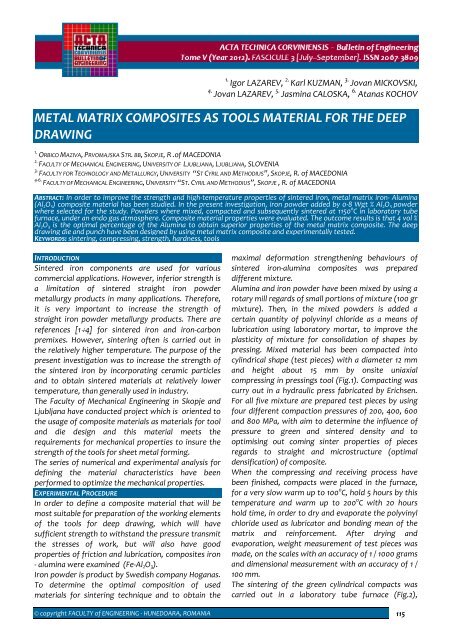1 - Acta Technica Corviniensis
1 - Acta Technica Corviniensis
1 - Acta Technica Corviniensis
You also want an ePaper? Increase the reach of your titles
YUMPU automatically turns print PDFs into web optimized ePapers that Google loves.
1.Igor LAZAREV, 2. Karl KUZMAN, 3. Jovan MICKOVSKI,4.Jovan LAZAREV, 5. Jasmina CALOSKA, 6. Atanas KOCHOVMETAL MATRIX COMPOSITES AS TOOLS MATERIAL FOR THE DEEPDRAWING1. ORBICO MAZIVA, PRVOMAJSKA STR. BB, SKOPJE, R .of MACEDONIA2.FACULTY OF MECHANICAL ENGINEERING, UNIVERSITY OF LJUBLJANA, LJUBLJANA, SLOVENIA3.FACULTY FOR TECHNOLOGY AND METALLURGY, UNIVERSITY “ST CYRIL AND METHODIUS”, SKOPJE, R. of MACEDONIA4‐6.FACULTY OFMECHANICAL ENGINEERING, UNIVERSITY “ST. CYRIL AND METHODIUS”, SKOPJE , R. of MACEDONIAABSTRACT: In order to improve the strength and high‐temperature properties of sintered iron, metal matrix iron‐ Alumina(Al 2 O 3 ) composite material has been studied. In the present investigation, iron powder added by 0‐8 Wgt % Al 2 O 3 powderwhere selected for the study. Powders where mixed, compacted and subsequently sintered at 1150 o C in laboratory tubefurnace, under an endo gas atmosphere. Composite material properties were evaluated. The outcome results is that 4 vol %Al 2 O 3 is the optimal percentage of the Alumina to obtain superior properties of the metal matrix composite. The deepdrawing die and punch have been designed by using metal matrix composite and experimentally tested.KEYWORDS: sintering, compressing, strength, hardness, toolsINTRODUCTIONSintered iron components are used for variouscommercial applications. However, inferior strength isa limitation of sintered straight iron powdermetallurgy products in many applications. Therefore,it is very important to increase the strength ofstraight iron powder metallurgy products. There arereferences [1÷4] for sintered iron and iron‐carbonpremixes. However, sintering often is carried out inthe relatively higher temperature. The purpose of thepresent investigation was to increase the strength ofthe sintered iron by incorporating ceramic particlesand to obtain sintered materials at relatively lowertemperature, than generally used in industry.The Faculty of Mechanical Engineering in Skopje andLjubljana have conducted project which is oriented tothe usage of composite materials as materials for tooland die design and this material meets therequirements for mechanical properties to insure thestrength of the tools for sheet metal forming.The series of numerical and experimental analysis fordefining the material characteristics have beenperformed to optimize the mechanical properties.EXPERIMENTAL PROCEDUREIn order to define a composite material that will bemost suitable for preparation of the working elementsof the tools for deep drawing, which will havesufficient strength to withstand the pressure transmitthe stresses of work, but will also have goodproperties of friction and lubrication, composites iron‐ alumina were examined (Fe‐Al 2 O 3 ).Iron powder is product by Swedish company Hoganas.To determine the optimal composition of usedmaterials for sintering technique and to obtain themaximal deformation strengthening behaviours ofsintered iron‐alumina composites was prepareddifferent mixture.Alumina and iron powder have been mixed by using arotary mill regards of small portions of mixture (100 grmixture). Then, in the mixed powders is added acertain quantity of polyvinyl chloride as a means oflubrication using laboratory mortar, to improve theplasticity of mixture for consolidation of shapes bypressing. Mixed material has been compacted intocylindrical shape (test pieces) with a diameter 12 mmand height about 15 mm by onsite uniaxialcompressing in pressings tool (Fig.1). Compacting wascurry out in a hydraulic press fabricated by Erichsen.For all five mixture are prepared test pieces by usingfour different compaction pressures of 200, 400, 600and 800 MPa, with aim to determine the influence ofpressure to green and sintered density and tooptimising out coming sinter properties of piecesregards to straight and microstructure (optimaldensification) of composite.When the compressing and receiving process havebeen finished, compacts were placed in the furnace,for a very slow warm up to 100 o C, hold 5 hours by thistemperature and warm up to 200 o C with 20 hourshold time, in order to dry and evaporate the polyvinylchloride used as lubricator and bonding mean of thematrix and reinforcement. After drying andevaporation, weight measurement of test pieces wasmade, on the scales with an accuracy of 1 / 1000 gramsand dimensional measurement with an accuracy of 1 /100 mm.The sintering of the green cylindrical compacts wascarried out in a laboratory tube furnace (Fig.2),© copyright FACULTY of ENGINEERING ‐ HUNEDOARA, ROMANIA 115
















